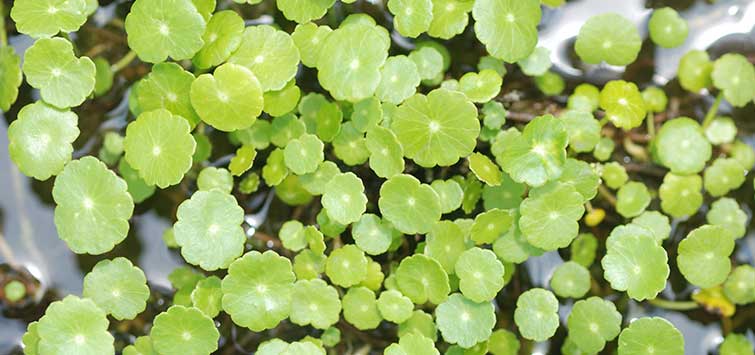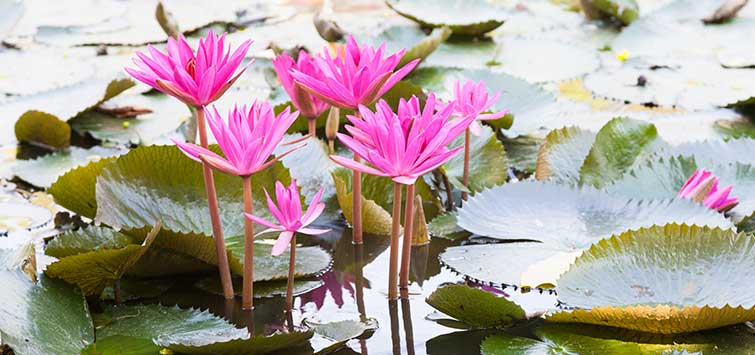The Planted Tank: From Pond to Aquarium
Author: Rhonda Wilson
I was browsing through discounted books on a shopping trip last winter, and I found a nice little one on pond plants. Now, I’ve had tubs and kiddie pools, and once in high school a short-lived small pond that the garter snakes thought was their own personal goldfish sushi diner, but I’ve never really done a formal pond, so I hadn’t really looked at the pond plant books. This was a foolish mistake on my part; I had no idea the selection of pond plants was so large! I also recognized several plants in the pond books that I was growing in my aquariums. Many of these I already knew were crossovers—plants that were popular in both pond and aquarium. But I also noticed several “new” plants, ones that I had recently acquired for my tanks that previously weren’t as commonly used.
There are quite a few plants that will live happily in your pond or in your aquarium. Since fall is rapidly approaching, I thought this would be a good time to look at some of the issues involved with transferring plants from outside in the pond to inside in the aquarium.
There are two major concerns in moving aquatic plants from an outside source to inside your home aquarium. First, you don’t want to introduce unwelcome organisms to your tank. These could include algae, insect larvae, or worms, among others. The second concern is trying to keep the plants alive while you transition them to a very different environment.
There are several options you have in regard to keeping unwelcome guests on any plants you may wish to transfer out of your tanks. There’s a sliding scale of options depending on how much you want to keep out and how much you’re willing to stress the plants to achieve that end.
QUARANTINE TANKS
Quarantine tanks are important for bringing new fish into your aquariums and can also be very useful for introducing new plants. A plant start-up or quarantine tank can be useful not only for bringing in plants from the outside, but also for starting off any new plant. Plants often have a period of adjustment. Whether it’s an older plant being transferred from your pond, or a new one purchased from the shop, many plants can experience some die-off and new growth before settling in to life in the aquarium. Using a plant quarantine tank can keep this from happening in your show tank.
When setting up a special aquarium for bringing in plants from your pond, whether you want to encourage or discourage the invertebrates that may come in with them, you will still need to set the aquarium up properly. Remember that you need to take as much care in providing lighting, nutrients, temperature control, filtration, and cleaning as you would with any other aquarium. The tank should be prepared and cycled in advance in order to achieve the best results with your outside plants. Lighting is particularly important, as these plants have been growing outside where the lighting is naturally obtained from the sun. Don’t scrimp on plant care just because this is a quarantine tank. These plants will have to make some major adjustments, and some may need tender care if they’re going to survive the transition.
The more extreme the change in environment, the more likely you will have die-off from your plants. Plants that have lived in very cool water will often have more trouble adjusting to the warmth of a home aquarium.
INVERTEBRATE AQUARIUMS
Some of the creatures that may be on outdoor aquatic plants are interesting enough in their own right, though most are not suitable to be housed with fish. In many instances it’s a matter of eat or be eaten. Dragonfly larvae will be happy to eat your small fish, and most fish will be happy to eat any small invertebrates they can. If you are interested in seeing some of the insects or other small invertebrates that may be found in a pond, you should do this in a separate aquarium. Just adding these things to most established home aquariums with tropical fish is asking for trouble.
Even in a tank set up specifically for the invertebrates, remember that they will still need food and will most likely eat each other if they are carnivorous—which many are. Basically you will need to feed these animals just like you need to feed your fish. A few may eat flake or frozen foods, but others will only survive on a steady diet of live foods. I have had success with carnivorous aquatic insects by feeding them mosquito larvae, just be careful that they don’t end up maturing and flying around your house. Smaller invertebrates that may show up in your tanks, like snails, worms, Daphnia, and Cyclops, will usually be able to find enough food in the aquarium to take care of themselves. They are also very likely to become food for the larger invertebrates that may be in the tank.
Most aquarists aren’t as interested in keeping these types of freshwater invertebrates and would like to just get the plants clean and free of such things. There is also the very likely possibility of introducing new algae into your aquarium with outside plants, and almost all of us that enjoy planted aquariums do not enjoy the algae that may invade our tanks.
CLEAN AND INSPECT
There are several options for reducing or ridding outdoor aquatic plants of stowaway invertebrates and algae.
First you should visually inspect and hand-clean the plants. This is usually easy to do in a plastic tub full of cool, clean water, as lighter colors make things easier to see. Remove any algae, leaves covered with algae, and any leaves or stems that are soft, mushy, or discolored in any way.
Remember that the most important part of any rosette type of plant will be the central area where the leaves and roots grow from. If this area doesn’t seem healthy, or is mushy or smells bad, then that part of the plant is dead. Use healthy, firm plants when transferring from outside.
In stemmed plants, the important part of the plant is the node. This is the area where roots and leaves grow from, and also where new stems will form. When trimming stemmed plants make sure you leave several nodes to each piece. To have the best chances with your plants you need at least one or two nodes to go under the substrate, and two or more to go above. Even if the current leaves need to be removed, new growth should come from the nodes.
You should also inspect the plants for snails, eggs, insect larvae, and other invertebrates. If you want to keep them you’ll want to check the water to save them for your wild freshwater invertebrate aquarium. If you want them to go away you’ll want to be careful to remove them from your plants. Even if you want to try to keep only some, it’s nice to know what you have, and you may wish to separate some of the larger carnivorous animals.
DIPS AND OTHER TREATMENTS
There are several methods for thoroughly cleaning plants, and they are meant to kill any remaining algae or invertebrates. I tend to like surprises and I haven’t personally used any of these dips for my plants. There is a risk that the dips can kill not only the undesirable things in plants but also the plants themselves. Still, there are many people I know who have incredible tanks and won’t put a plant in them if it hasn’t been dipped beforehand.
Potassium permanganate is considered one of the safest dips. This is mixed with water to make a dark pink dip. Plants are left in it for 10 minutes, longer with more risk of injuring the plant. Plants are then rinsed well with dechlorinated water before being added to the tank.
A similar treatment that is more extreme and has a greater risk of killing your plant uses 19 parts water to 1 part household bleach. Plants are dipped for no more than three minutes (some delicate plants like mosses can stand no more than two minutes). The plants are then rinsed in water with an extra large dose of dechlorinator.
The information I’ve given about dipping plants is very general. If you’re interested in dipping your plants you should do some extra research, as there are other methods used, including one that uses alum and another using hydrogen peroxide. Any plant dipping should be done with caution, for your own safety and that of your plants and fish. A quick online search can give you more detailed information on the different types of plant dips that others have recommended.
A FEASIBLE OPTION
Whether you’re interested in a better understanding of the secret life of your pond, are curious about trying some new plants in your aquarium, or are trying to keep some of your pond plants alive through the winter, bringing them inside can be an interesting new option for your planted aquarium hobby.
See the full article on TFH Digital http://www.tfhdigital.com/tfh/200709/#pg50

.png?h=595&iar=0&w=2781&hash=5FD5E69473BCC22199FBFA2FB71B6033)



